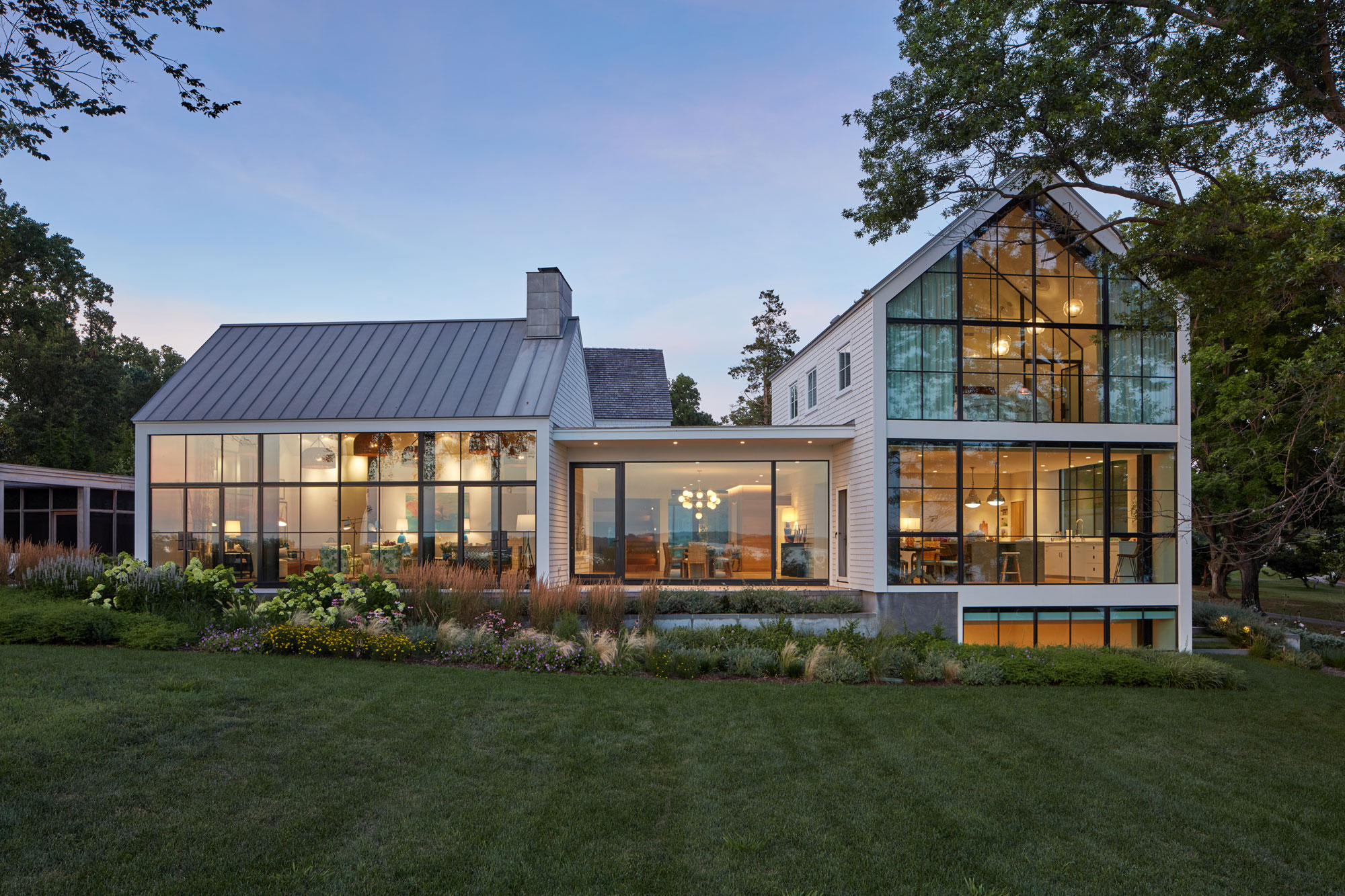- © 2025 Annapolis Home Magazine
- All Rights Reserved

When one puts a match to dry tinder, there is a satisfying flash, a blaze just as the fire begins. Something similar happens when architect, landscape architect, and interior designer work together early on: if conditions are right, the embers ignite. In such homes, there is often a high level of creativity, from gardens to roof peak to interiors. This is the case with a second home on Gibson Island designed for a family from the metropolitan area. The couple wanted a place where their young children could grow up and later return with their own families to savor old memories and create new ones.
Gregory Ehrman AIA, partner at Hutker Architects, was able to design a modern home with private and public spaces, where children could be closely watched when younger and allowed freedom when older. There are three separate structures connected by a glass-enclosed hyphen-like room, that, as a dining area, centers the house. It is surrounded by a generous living room with tall cathedral ceilings, a barn-like garage with map-lined bunkroom, a kitchen with master suite above, and a two-story wing with three-bedroom suites, plus a family room.
“The original home was a colonial ‘box’ set smack in the middle of the view,” he recalls. The glass room, however, transports visitors right to the water the moment they approach the house, explains Ehrman. In fact, the way one approaches a home is crucial to good design. “Planning a landscape early on is essential—we can’t think about a house without thinking how to get there,” he says.
They agreed that the home’s geometric angles could be softened by a wild garden designed by Campion Hruby Landscape Architects. With its different roof planes and angles, this home has a definite geometry. The garden counters and blurs these edges, explains Ehrman. Yet, it has its own structure, but one that is wind-driven: shifting forms and planes reveal themselves as the sun travels across the sky. “The thing that makes a garden wild is that there is no apparent geometry,” explains Hruby. “There is a wildness; a naturalism is achieved. Weeping things are punctuated by the vertical; all is animated by the wind.”
Ehrman calls what Hruby and his team bring to the project “local know-how” and much more. With knowledge of the topography, soil, and grading protocols, and of how plants behave and respond to the environment, they pull together many bits and pieces for the architect who can better create a sustainable, unified whole.
For example, the grassy terrace steps and low stucco walls within the gardens achieve an aesthetic intrigue but also correct the grade, create flat, usable space, and draw nature toward the house.
There are plants with different textures and habits, explains Hruby. The garden is also devised to attract bees and other pollinators. The movement of insects on the plants brings the garden alive. By leaving the garden intact through all four seasons, birds and animals find natural habitats and insects have a chance to lay eggs, thus providing food sources for the animals.
He points out how the home’s modern sensibility and angles between buildings shape the garden. This is not a beaux arts garden, with linear allées and hedges driven by symmetry, or classical sculptures as focal points “where an urn may have to be placed in a precise spot,” he says. Rather, this garden is shaped by land and unfolding views. “The plantings have a tranquil calming effect on stark geometry. Though wild, it still feels ‘designed,’” explains Hruby. “There is a sculptural element: a sculpture that you walk through.”
A closer look at the plantings reveals many sturdy native plants and resilient grasses. With its soft palette colors and windswept beauty, it certainly has the look of a “Chesapeake garden.” But what exactly is that? “A Chesapeake garden is not a formula, or prescribed approach, but an intuitive response to the garden’s surroundings, which are always changing,” explains Hruby.
Interior designer Lauren Leiss understands change and draws from the seasonal flora and fauna for inspiration. For example, the rush-colored dome pendants in the living area speak to the natural grasses as they age throughout the seasons. The blues, wheats, and creams reference the hues of a shucked oyster upon its shell, the delicate browns and translucent oranges recall the soft crab in early summer, and the many blues reference the subtle accumulation of color that distinguishes the blue crab.
This kind of integration is what makes this home successful, what makes it a landscape and “an architecture of ever-changing light,” says Ehrman. A visible conversation flows between the interior design and the plantings and creatures, interlacing the home’s architecture, the gardens, and the Bay itself.
It is an example of the creative powers possible through interdisciplinary collaboration, when even the interstices, the empty spaces, encourage a deeper relationship with the natural world.
ARCHITECTURE: Hutker Architects, hutkerarchitects.com, Vineyard Haven, Massachusetts | LANDSCAPE ARCHITECTURE: Campion Hruby Landscape Architects, campionhruby.com, Annapolis, Maryland | INTERIOR DESIGN: Lauren Liess, laurenliess.com, Great Falls, Virginia | BUILDER: Michael Banks, The Banks Development Co., banksdevco.com, Washington, DC
Annapolis Home Magazine
Vol. 12, No. 3 2021